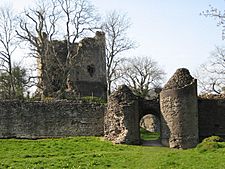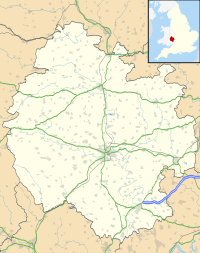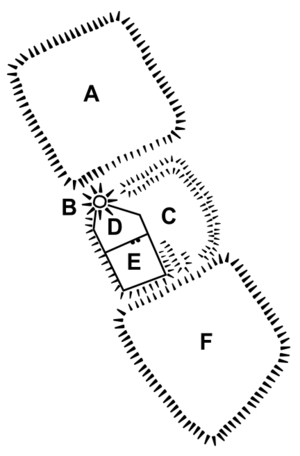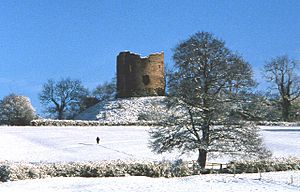Longtown Castle facts for kids
Quick facts for kids Longtown Castle |
|
|---|---|
| Longtown, Herefordshire, England | |

The keep and inner gatehouse, 2007
|
|
| Coordinates | 51°57′22″N 2°59′28″W / 51.9562°N 2.9910°W |
| Site information | |
| Owner | English Heritage |
| Open to the public |
Yes |
| Site history | |
| Materials | Stone |
Longtown Castle is a ruined Norman castle in Longtown, Herefordshire. It was also known as Ewias Lacey Castle long ago. This castle was built in the 11th century by Walter de Lacy. He used parts of an old Roman fort to help build it.
Later, around 1148, Gilbert de Lacy rebuilt the castle using stone. He also started a town nearby to help pay for the work. By the 1300s, Longtown Castle was not used as much. It was briefly used again in 1403 during the Owain Glyndŵr uprising. But after that, it became a ruin. Today, English Heritage looks after the castle. It is a popular place for visitors to explore.
Contents
History
Early Beginnings
The very first fort at Longtown was built by the Romans. It was near a Roman road that followed the border. This Roman fort was square. It had a ditch and a wooden fence for protection. These Roman defenses were made stronger around 1055. This happened after a Welsh attack on Hereford.
Building the Castle
After the Normans took over England and Wales in the late 1000s, a small castle was started. Walter de Lacy began building it at Pont Hendre. This was close to where Longtown Castle is now. He wanted to protect the river crossing there.
After some Welsh attacks, Walter moved his building efforts. He started a new castle at Longtown. This was on the site of the old Roman fort. The early castle was sometimes called Ewias Lacey. This name came from the larger area, "Ewias," which meant "sheep district."
Longtown Castle was a motte and bailey castle. This means it had a large mound (the motte) and a walled area (the bailey). It was built on high ground near the River Monnow. Even though there were higher places nearby, this spot was good for controlling the river. The river was an important way to travel.
The castle had a motte about 10 meters (33 feet) high. It also had an unusual rectangular bailey. This bailey was about 125 meters (410 feet) by 110 meters (360 feet). It was divided into three parts. Two baileys were on the west, and one was on the east. Each part could be defended on its own. The total area was about 1.21 hectares (3 acres).
The castle built in the 1100s was mostly made of timber. But it also had some stone. This stone was later reused when the castle was rebuilt. Two sets of earthworks were to the north and south of the castle. These might have had wooden fences. They surrounded the early settlement of Longtown. The area was often troubled by revolts from the local Welsh people. They were fighting against Anglo-Norman rule.
Stone Castle and Changes
The de Lacy family lost their lands for a while. This was because they plotted against King William II. But around 1148, Gilbert de Lacy got the lands back. Gilbert likely rebuilt the castle using stone. This was very expensive, costing about £37. He paid for it by building a new town next to the castle.
The stone tower, called the keep, was round. Its walls were about 5 meters (16 feet) thick. It had three small towers spaced around the outside. There was a hall on the first floor. This round design was common in the Welsh Marches area. You can also see it at Skenfrith and Caldicot. We don't know exactly why this design was chosen. It didn't seem to offer many military benefits.
The castle walls were made of shale rubble. They had cut stone details. The walls were about 4 meters (13 feet) thick. But the keep's foundations were very shallow. An inner gate to the western baileys was built simply. It had two small towers and a portcullis, a heavy gate that could be lowered. A 2-meter (6.5 feet) thick wall surrounded the rest of the inner western bailey. Another stone wall likely protected the outer part of the bailey. Inside the inner western bailey, there was probably the castle's great hall and other service buildings.
Castle's Later Years
The de Lacy family owned Longtown Castle until Walter de Lacy died in 1234. After that, different families owned the castle. This was a time of more fighting between Welsh princes and English lords. The castle was still used as a fort. In 1317, orders were given to have 30 men guard it.
However, the castle slowly became less important. By 1369, it passed to the Despensers and then the Beauchamps. Neither family used the castle much. It was briefly made stronger again by King Henry IV. This was in response to the Owain Glyndŵr uprising in 1403. The Nevilles family got the property in the 1400s. They controlled it until the 1970s.
After the Black Death, the town's population dropped a lot. The protected area north of the castle was left empty. By the 1500s, Longtown was no longer a busy trading center.
It's not clear if the castle was used during the English Civil War (1642–1645). But cannonballs from that time have been found there. Local stories say the castle was "slighted." This means it was deliberately destroyed during the war. People started using stones from the castle to build other things from the 1600s onwards. By the 1700s, a house and shop were built in the eastern bailey. There was also a yard and garden. A gallows, a structure for hangings, was used at the castle until 1790. More buildings continued to be built around the castle. By the late 1800s, a school and a house, Castle Lodge, were in the castle grounds. Other buildings were built leaning against the castle walls.
Modern Times
Longtown Castle was taken over by the Ministry of Works in the 1970s. It was in poor condition. A lot of restoration work was done. Many of the buildings that had been built against the walls were removed.
Today, the main parts of Longtown Castle are looked after by English Heritage. This includes the ruined keep, the inner gatehouse, and parts of the curtain wall. It is a place for tourists to visit. The wider earthworks are on common land. In 2016, a local history group got money to research Longtown Castle. The castle is protected as a scheduled monument.




